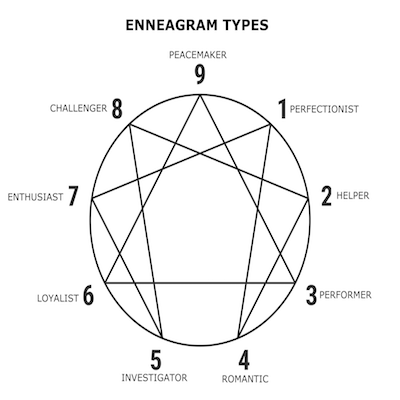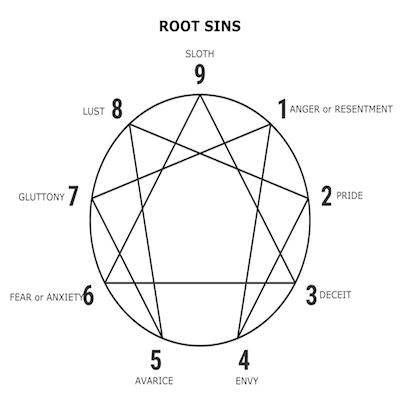The Enneagram has changed every area of my life. Marriage. Parenting. Faith. All of it. I talked about this in a previous post. I believe the Enneagram can transform your life by revealing who you really are, expanding your capacity for empathy and compassion, and helping you realize your potential.
The next two posts will unpack the nuts and bolts of this tool, why it works, how it works, etc. Along the way, you will encounter fierce resistance and probably humiliation. But you will also find your true self, and I promise you no discovery is more valuable.
What the heck is the Enneagram?
Glad you asked. Well, you didn’t really. I assumed you were thinking it. Does that make me a mind reader? Anyway.
The Enneagram (pronounced “Any-a-gram”) comes from two Greek words: ennea (“nine”) gramma (“type” or “sign”). Now, that’s disarming, isn’t it? Enneagram…nine types. Let’s keep going.
I said this in the previous post, but hear me say it again. The Enneagram is not the tool for spiritual transformation. But it is the most effective tool I’ve ever encountered. GM, Sony, Toyota and the Oakland A’s apparently agree. All these organizations use the Enneagram on either an individual or corporate level, or both.
Self Awareness…The First Step To Spiritual Transformation
The fuel that runs the Enneagram is self-awareness. If you’re not willing to look in the mirror and wrestle with some difficult truths about yourself, you should stop here.
The Enneagram isn’t primarily about types. It’s primarily about transformation, about letting go of who you think you are and discovering your true identity.
The Enneagram is about transformation, letting go of who you THINK you are and discovering your true identity.
Self-awareness (looking at the man in the mirror) opens the door to self-knowledge (oh, crap, I am angry and bitter). Self-knowledge paves the way to insight (this is why I’m angry and bitter). And insight is the gateway to spiritual transformation (letting go of the behaviors that cause your anger and bitterness). Depending on your number, you might replace anger with codependency or judgementalism or materialism.
That’s a mouth full, I agree. Make sure you chew it up good before you swallow. Take as much time as you need.
Without further adieu, here are the nine Enneagram types.
The Nine Enneagram Types

(The descriptions below are taken from The Road Back To You by Ian Morgan Cron and Suzanne Stabile.)
Type 1 (The Perfectionist) — Ethical and reliable, they are motivated by a desire to live the right way, avoid fault and blame, and improve the world.
Type 2 (The Helper) — Warm, caring, and giving, they’re motivated by a need to be loved and needed, and to avoid acknowledging their own needs.
Type 3 (The Performer) — Success-oriented, image-conscious and wired for productivity, they are motivated by a need to be (or appear to be) successful and avoid failure.
Type 4 (The Romantic) — Creative, sensitive and moody, they are motivated by a desire to be understood, experience their over-sized feelings and avoid being ordinary.
Type 5 (The Investigator) — Analytical, detached and private, they are motivated by a desire to gain knowledge, conserve energy and avoid relying on others.
Type 6 (The Loyalist) — Committed, practical and witty, they are motivated by fear and the need for security.
Type 7 (The Enthusiast) — Fun, spontaneous and adventurous, they are motivated by a need to be happy, to plan stimulating experiences and to avoid pain.
Type 8 (The Challenger) — Commanding, intense and confrontational, they are motivated by a need to be strong and avoid feeling weak or vulnerable.
Type 9 (The Peacemaker) — Pleasant, laid back and accommodating, they are motivated by a need to keep the peace, merge with others and avoid conflict.
I know what you’re thinking. “Only nine types?! This is bogus. Erroneous. I’m out.”
Loosen your belt buckle a couple notches, and hear me out. The Enneagram says you identify with one type, but within each number lies an infinite number of subtypes. Ian Cron describes it this way: you might be the color red, for instance. Visit any paint store, however, and you quickly realize there are 100 million billion shades of red.
It’s not possible to look at the Enneagram and say it’s untrue. Richard Rohr, whom I consider an Enneagram Jedi of the first degree, says the only people who don’t think the Enneagram is true are those who never study it.
One more point about the types, and it’s a big one: no type is better or worse than another. Every type reveals something beautiful and redemptive about God’s character.
What kind of sinful are you?
We live in an age of flattery. Almost everything, from church to social media, feeds our ego. People who disagree with us are filtered from our timelines and checkbooks.
The Enneagram is unconcerned with stroking egos. I would argue its foundational purpose is to reveal our shadow side, to illuminate the black hole of darkness we conveniently overlook. This darkness also hides are true identity.
The central goal of the Enneagram is to reveal your shadow side, your deadly sin, so you can begin to uncover your divine virtue.
The light, however, isn’t a condemning or judgmental one. It’s the light of grace and love, the Light described by the Apostle John in the first chapter of his gospel. Yes, the Light wants you to see your sin. But don’t think angry old preacher in a three-piece suit. Think soft, kind voice of a loving Father reaching out his hands, overwhelming you with love and grace.
So, each type has a unique deadly sin or passion, a blockade or wall that prevents you from deeper connection with God. Here are the 9 sins, one for each type.
Please read the descriptions for each. Several sins don’t flesh out the way you might think.
The Deadly Sins or Passions

Type 1 (Anger or Resentment) — Ones are fixated on perfection. They need everyone and everything “buttoned up,” doing things the right way. Because no one meets their astronomically high standards, Ones fill up with anger that boils over in the form of resentment.
Type 2 (Pride) — Twos are keenly aware of everyone’s needs, which is noble, except in doing so Twos ignore their own needs. While they’re natural givers, Twos struggle mightily to receive, either from a neighbor or from God. Their pride comes in believing they’re indispensable, more false humility than boastfulness.
Type 3 (Deceit) — Threes are image conscious. They have an uncanny ability to appear successful, knowledgeable and important, regardless of the crowd. They deceive others, yes. But ultimately Threes deceive themselves by allowing their ego or persona to become their identity.
Type 4 (Envy) — Fours are always missing something. Always. Everyone else seems so freaking happy and content. Fours are fixated on being special, different, and authentic, and they’re often driven by their emotions, which are many and often.
Type 5 (Avarice) — Avarice seems archaic. Why not use greed? Because it’s the wrong word. Greed is a thirst for more material possessions and money. Fives aren’t as much concerned with acquiring more as they are with hoarding the things they have. They’re fixated on being independent, and seeing a world of lack, they often withhold love and affection from those closest to them.
Type 6 (Fear or Anxiety) — The world is a scary, dangerous place. So says a Six, anyway. Sixes are doomsday and worst-case scenario specialist. They’re always looking for some authority or leader to make them feel secure. For a six, the “fit is always about to hit the shan.”
Type 7 (Gluttony) — Don’t think food. Think excess. Sevens do everything “too much” in an attempt to avoid the present. In particular, they avoid anything that’s presently hard or painful. Sevens are fixated on immediate gratification, making them especially vulnerable to addiction.
Type 8 (Lust) — Eights aren’t lustful in a sexual way. They lust after intensity. Eights are confident, confrontational and domineering. Their motto is, “Act now. Ask for forgiveness never.” If they had a logo, it would be an exclamation mark. Eights avoid vulnerability like I avoid cats (hellish creatures), and their greatest fear is being controlled.
Type 9 (Sloth) — Nines aren’t physically lazy. Sloth refers to spiritual apathy. Nines avoid conflict at all cost. Everyone always seems too serious, too demanding, too angry, too clingy. The world would be a much better place if everyone had a glass of wine and a chill pill. Lacking focus and drive, Nines can go the entirety of their lives without a true identity or purpose.
I’ll end the suspense. I’m an Enneagram Type 9. I often feel overlooked and believe my opinion matters not. I struggle to start new projects and can quite naturally sleepwalk through life. Most of my life, I’ve found it odd that I can feed off almost anyone, which allows me to see different perspectives but keeps me from establishing my own. To realize my Type was hugely important because it opened the door to my virtue, and subsequently to transformation.
In the next post, I’ll introduce the virtue for each Enneagram Type, as well as a few tips for discovering your number.
Grace and peace, friends.


Brysen
Thanks for inidoructng a little rationality into this debate.